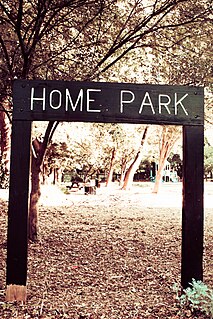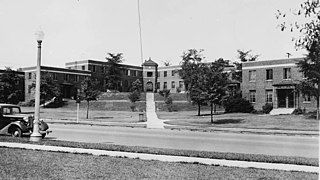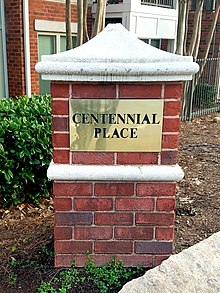The city of Atlanta, Georgia is made up of 243 neighborhoods officially defined by the city. These neighborhoods are a mix of traditional neighborhoods, subdivisions, or groups of subdivisions. The neighborhoods are grouped by the city planning department into 25 neighborhood planning units (NPUs). These NPUs are "citizen advisory councils that make recommendations to the Mayor and City Council on zoning, land use, and other planning issues". There are also a variety of other widely recognized named areas within the city; some are officially designated, while others are more informal.

Home Park is a neighborhood of Atlanta in Georgia, US. It is bordered on the south by Georgia Tech, on the west by the railroad yards adjacent to Marietta Street and Brady Avenue, on the north by 16th Street at Atlantic Station, and on the east by Techwood Drive at I-75/85.
The neighborhood planning unit (NPU) is a neighborhood-scale governmental structure used in the city of Atlanta, Georgia.

Atlanta is the capital and largest city in the state of Georgia. Atlanta ranks as the 38th-largest in the United States, and the sixth-largest city in the southeastern region. 2010 census results varied dramatically with previous Census Bureau estimates, counting 550,003 residents. Atlanta is the core city of the ninth most populous United States metropolitan area at 5,268,860, with a combined statistical area of 5,626,400. A 2015 article, written by Nate Silver of fivethirtyeight.com, found that Atlanta was the second most segregated city in the U.S.

Techwood Homes was an early public housing project in the United States, opened just before the First Houses. Located in Atlanta, Georgia, it replaced an integrated settlement of low-income people known as Tanyard Bottom or Tech Flats. It was completed on August 15, 1936, but was dedicated on November 29 of the previous year by U.S. President Franklin D. Roosevelt. The new whites-only apartments included bathtubs and electric ranges in each unit, 189 of which had garages. Central laundry facilities, a kindergarten and a library were also provided. Techwood Homes was demolished in advance of the 1996 Olympics and is now Centennial Place Apartments.
HOPE VI is a program of the United States Department of Housing and Urban Development. It is intended to revitalize the worst public housing projects in the United States into mixed-income developments. Its philosophy is largely based on New Urbanism and the concept of defensible space.
Mechanicsville is a neighborhood of Atlanta, Georgia. It sits just south of downtown Atlanta.

Centennial Hill is district at the northern edge of Downtown Atlanta, Georgia. The name was originally coined by Hines Interests and applied only to their planned development in the area. Although the development was never started and the land later sold, the name remained and became associated with the whole neighborhood. Due in part to the Georgia Aquarium and to renewed interest in city living, Centennial Hill is undergoing a development boom estimated at over US$1 billion. This includes Allen Plaza, an eight-block complex that spans many side streets and borders Ivan Allen. The seasoned developer's project had already delivered the north end of downtown a modern fresh look, with glass buildings that accommodated Southern Co. and Ernst & Young looming over the Downtown Connector and a W Hotel nearby.

Westview is a historic intown neighborhood located in southwest Atlanta, Georgia. It is named for the Westview Cemetery that borders the neighborhood to the northwest. The neighborhood is made up of a mixture of architectural styles including Arts & Crafts bungalows, Four-Squares, Tudors, Minimal Traditional houses, and Ranch style houses.
East Lake is a neighborhood on the east side of Atlanta, Georgia, situated in DeKalb County. It is the easternmost of the 238 neighborhoods in the City of Atlanta. It is home to East Lake Golf Club, the site of PGA's annual Tour Championship. East Lake lies mostly within the 30317 zip code.
The Atlanta Housing Authority (AHA) is an agency that provides affordable housing for low-income families in Atlanta. Today, the AHA is the largest housing agency in Georgia and one of the largest in the United States, serving approximately 50,000 people.

Summerhill is a neighborhood directly south of Downtown Atlanta between the Atlanta Zoo and Center Parc Stadium. It is bordered by the neighborhoods of Grant Park, Mechanicsville, and Peoplestown. Established in 1865, Summerhill is one of Atlanta’s oldest neighborhoods and part of the 26 neighborhoods making up the Atlanta Neighborhood Planning Unit system.

Subsidized housing in the United States is administered by federal, state and local agencies to provide subsidized rental assistance for low-income households. Public housing is priced much below the market rate, allowing people to live in more convenient locations rather than move away from the city in search of lower rents. In most federally-funded rental assistance programs, the tenants' monthly rent is set at 30% of their household income. Now increasingly provided in a variety of settings and formats, originally public housing in the U.S. consisted primarily of one or more concentrated blocks of low-rise and/or high-rise apartment buildings. These complexes are operated by state and local housing authorities which are authorized and funded by the United States Department of Housing and Urban Development (HUD). In 2020, there were 1 million public housing units.

Pittsburgh is a neighborhood of Atlanta, Georgia, founded in 1883 as a black working-class suburb alongside the Pegram rail shops. It was named Pittsburgh because the industrial area reminded one of Pittsburgh, Pennsylvania and its famous steel mills. Pittsburgh is a working class and developing neighborhood, and as property values rise in Intown Atlanta neighborhoods, many see possibility that this trend will spread to Pittsburgh while bringing renewal for legacy residents.
In 1994 the Atlanta Housing Authority, encouraged by the federal HOPE VI program, embarked on a policy created for the purpose of comprehensive revitalization of severely distressed public housing developments. These distressed public housing properties were replaced by mixed-income communities.

English Avenue and Vine City are two adjacent and closely linked neighborhoods of Atlanta, Georgia. Together the neighborhoods make up neighborhood planning unit L. The two neighborhoods are frequently cited together in reference to shared problems and to shared redevelopment schemes and revitalization plans.

Gentrification of Atlanta's inner-city neighborhoods began in the 1970s, and it has continued, at varying levels of intensity, into the present. Many factors have contributed to the city's gentrification. A major increase in gentrification that occurred in the last years of the twentieth century has been attributed to the 1996 Summer Olympics. However, during the 2000s, Atlanta underwent a profound transformation demographically, physically, and culturally. Suburbanization, rising prices, a booming economy, and new migrants decreased the city’s black percentage from a high of 67% in 1990 to 54% in 2010. From 2000 to 2010, Atlanta gained 22,763 white residents, 5,142 Asian residents, and 3,095 Hispanic residents, while the city’s black population decreased by 31,678. Much of the city’s demographic change during the decade was driven by young, college-educated professionals: from 2000 to 2009, the three-mile radius surrounding Downtown Atlanta gained 9,722 residents aged 25 to 34 holding at least a four-year degree, an increase of 61%. Between the mid-1990s and 2010, stimulated by funding from the HOPE VI program, Atlanta demolished nearly all of its public housing, a total of 17,000 units and about 10% of all housing units in the city. In 2005, the $2.8 billion BeltLine project was adopted, with the stated goals of converting a disused 22-mile freight railroad loop that surrounds the central city into an art-filled multi-use trail and increasing the city’s park space by 40%. Lastly, Atlanta’s cultural offerings expanded during the 2000s: the High Museum of Art doubled in size; the Alliance Theatre won a Tony Award; and numerous art galleries were established on the once-industrial Westside.
Charles Forrest Palmer was an Atlanta real estate developer who became an expert on public housing and organized the building of Techwood Homes, the first public housing project in the United States. He would later head up both the newly created Atlanta Housing Authority and the Chamber of Commerce.

Howard County Housing is the umbrella organization for the Howard County Department of Housing and Community Development and the Howard County Housing Commission. The Department is Howard County Government’s housing agency and the Commission is a public housing authority and non-profit. Both have boards that meet monthly.
The Olympic Legacy Program was an initiative taken in effort to revitalize many of Atlanta’s public housing projects in the early 1990s in preparation for hosting the 1996 Olympic Games. The initiative, guided by the principals of “new urbanism” was proposed as a way to transform thirteen former projects scattered throughout the city. The initiative began with Techwood Homes in downtown Atlanta, Clark Howell Homes, and continuing to several other projects in each zone. The program was led by former Atlanta Housing Authority (AHA) CEO Renee Glover. While the project's ultimate effect was to reduce the concentration of poverty in the city, and improve neighborhoods, employment and education opportunities, finding housing for some of the poor shifted to suburban housing which lacked many of the social services of government housing.











